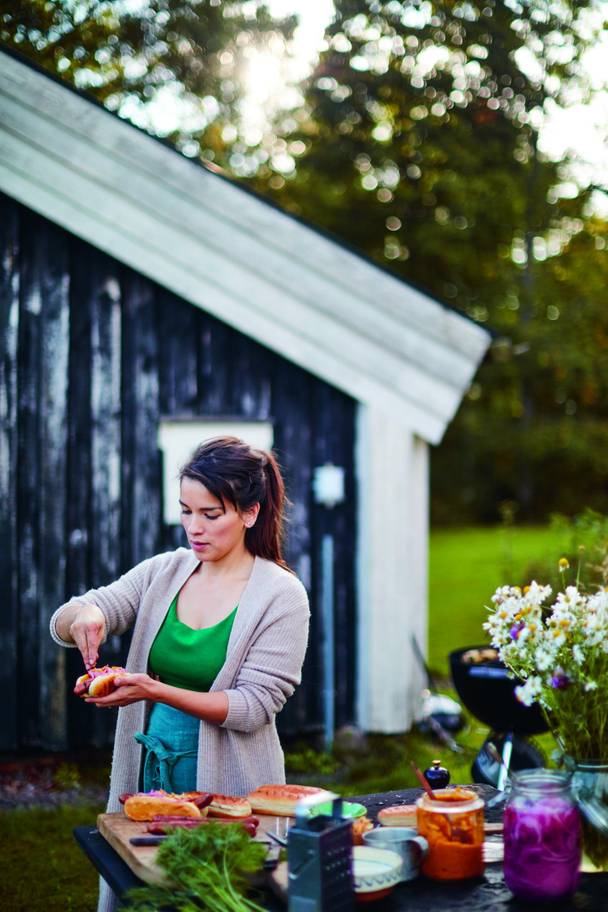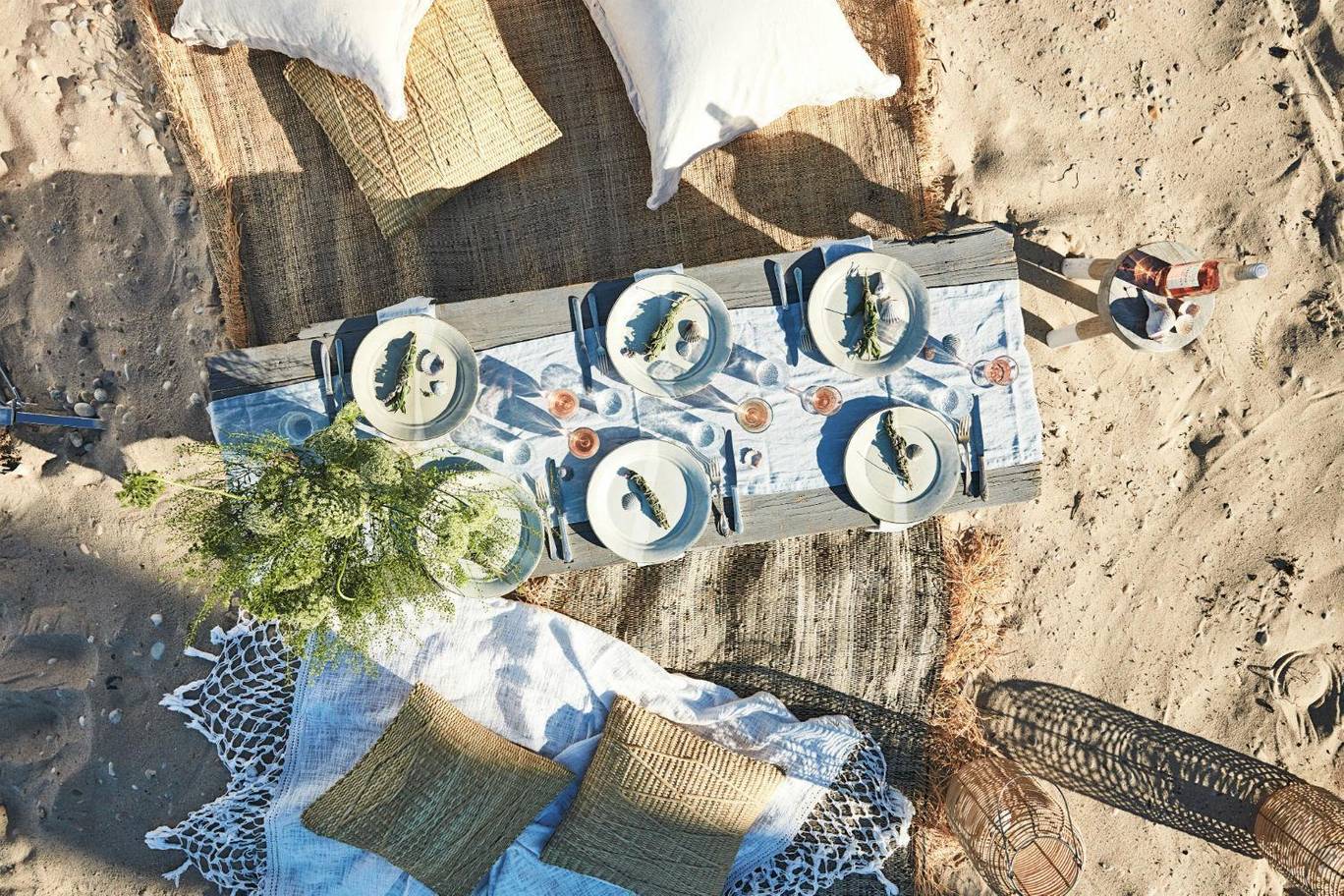A conversation with Rachel Khoo, author of The Little Swedish Kitchen
The author of The Little Swedish Kitchen also reveals two of her most delicious recipes
24 August 2018
Rachel Khoo's fifth cook book, The Little Swedish Kitchen, is a vibrant culinary tale of Swedish classics along with lesser known dishes.
Championing the seasons and bountiful local produce, this book will have you instantly heading for the kitchen.
After working with world renowned chef Magnus Nilsson, Khoo moved to Sweden with her husband and keenly celebrates her adopted home in this new book.
Where’s home for you?
Home for the last several years has been Stockholm (most of the time). Although I’m in London at least once a month and spend quite a bit in the South of Sweden at our house in the countryside.
What inspired you to write the book?
The last four cookbooks I’ve written have always been a way of documenting a personal journey. The Little Paris Kitchen was about my experience of living and cooking in Paris, My little French Kitchen about my travels around France and Rachel Khoo’s Kitchen Notebook was a peek into my personal cooking diary with influences from around the world. It felt only natural to write a cookbook about Swedish food and how I discovered the culture, people and language when I moved here several years ago. I’ve always felt the easiest way to get to know new culture is through its food even if you don’t speak the language. Food will do it for you. It’s an universal language.
Who should buy it?
Even though the underlining theme of the cookbook is Swedish food it is not a book with over 100 different ways to make meatballs. I divided the chapter into the four seasons and each season has a range of recipes from simple suppers, dishes to wow friends and family or sweet treats. What I discovered while researching the cookbook that Swedish food has its roots in simplicity. It doesn’t require a cupboard full of exotic spices. Most of the ingredients you probably already have in your fridge or can easily get at your local supermarket. The geographical location of Sweden and, therefore, short growing season meant that the range of produce is not as abundant like say France, Italy or Spain. This influenced the cooking culture and forced cooks to be creative with a handful of ingredients. It’s a very modern way of cooking. In essence this cookbook is for any home cook who would like some seasonal inspiration for the ingredients they probably already have in their cupboard.
What's your favourite recipe from the book?
It’s impossible to pick one but one of my favourites is the Roasted Butternut Squash Waffles (scroll down to find the recipe). I love a waffle but adding the sweet nutty flavour of the butternut squash makes the waffles so much more flavoursome. Plus the bonus with this batter is you can have them either sweet (with a cloud like dollop of whipped cream and fresh berries) or savoury (the Swedish way would be with crème fraiche, finely chopped red onion and chives with some fish roe but you could also do grilled bacon and chopped tomato salad). Perfect for breakfast, brunch, a light lunch or dinner. And if you don’t have a waffle machine you could simply cook them like American style pancakes.
And your favourite no-fuss dinner recipe?
Stewed spinach eggs – think Swedish Shashuka. Instead of a spicy tomato sauce the eggs sit in a creamy spinach which is topped off with pink pickled onions (always have a jar in my fridge – such an easy way to liven up any dish from stews to salads), dill and some thinly sliced chilli.
Now your ultimate dinner party dish?
Chilled cucumber soup with beetroot yoghurt granita. One of the easiest mistakes to make when planning a dinner party is to serve too much heavy food. You want your guests to feel comfortable rather than bloated and rolling home. With all the hot weather this vibrant green cucumber soup is the perfect way to start a meal. It’ll refresh the guests and ready them for the other courses to come. The beetroot granita is a simple way to make the dish eye popping with it’s bright pink colour. I have served small espresso cup versions of this after a main course as a palate cleanser before the cheese or dessert course. It goes down a treat anytime of the year.
roasted butternut squash waffles
Cardamom bun bombe
Finally, your favourite dessert from the book?
Cardamom bun bombe (scroll down to find the recipe). It's a great way of using up day-old cardamom (or cinnamon buns) and a tub of vanilla ice cream. All you make is a slightly salty caramel sauce spiked with cardamom which you swirl into the ice cream (and keep some to pour over the dessert for serving). It’s effortless but looks impressive. Plus you can make it well ahead of time (even a month) and have it in the freezer for whenever you might need an emergency dessert.
Which chefs have influenced you and your approach to food?
Anthony Bourdain influenced me hugely with his approach to making food/travel TV and also his writing. He was able to touch on such a wide range of subjects through sitting down and having a meal. His evocative and descriptive use of words and constant striving to capture the place through cinematography nods to cult film directors.
Name your top 3 restaurants to eat out at:
I really miss spicy food living in Stockholm. I’d happily get my fix at Hoppers.
I grew up with eating Dim Sum in China town on Sundays with the old ladies pushing the trollies full of steaming baskets. Now I’m not so fussed about the trollies but the dim sum have to be good. I love BaoziInn.
My dad is from Malaysia so I grew up eating Laksa even having it for breakfast. The spicy broth from Shambal Shiok is the best hangover cure I know.
What cookery books do you always reach for from the shelf?
I have such a hotch potch of a collection. When I’m testing recipes I like to reach for books that are quite technical like The Food Laband McGee on Food and Cooking. I have a very well thumbed copy of The Flavour Thesaurus. It’s great to get ideas going when you need a little push with thinking differently with flavour combos.
Roasted butternut squash waffles
Makes 8 waffles | Prep time: 15 mins | Resting time: 20 mins | Cooking time: 30 mins | Equipment: Waffle Iron
INGREDIENTS:
waffles:
300g roasted butternut squash or pumpkin
100g cooled melted butter, plus extra for greasing the waffle iron
200g buttermilk
200ml whole milk
2 medium eggs
½ tsp ground cinnamon (optional)
1 tsp fine sea salt
200g plain flour
2 tsp baking powder
To serve as a sweet:
Strawberry Jam
Whipped cream
To serve as a savoury option:
4-6 tbsp crème fraîche
1 red onion, peeled and finely chopped
2 tbsp finely chopped fresh chives
2 – 4 tbsp Kalix or other caviar
Method
Mash the roasted butternut squash or pumpkin and mix with the butter, buttermilk, whole milk and eggs. Sift together the remaining waffle ingredients into the bowl and fold to incorporate. Don’t over mix or you’ll get a heavy batter. Leave to rest at room temperature for 20 minutes.
Heat up your waffle iron, brushing with melted butter if required (no need with non-stick ones). Pour a ladle of batter into the middle. Gently close the lid and cook for a couple of minutes or until the outside is crisp (this will vary, depending on the heat of your waffle iron).
Leave to cool for a minute before topping with the garnish of your liking.
Top tip / If you don’t have a wa½e iron, you could make small drop pancakes instead. Heat up a non-stick frying pan on a medium heat, then pour in a small ladleful of batter. Fry for a couple of minutes on each side until golden.
Get ahead / The batter can be made the day before and chilled. Take out of the fridge 30 minutes before using, so it returns to room temperature. This ensures a lighter, fluffier batter.
Cardamom bun bombe
Serves 6-8 | Prep time: 30 mins | Cooking time: 10 mins | Freezing time: 4 hours | Equipment: Medium Sized bowl (capacity 1.5 litres)
If you happen to have day-old, slightly stale buns lying around, this is a good way of using them up. I’ve also made this dessert using bought buns when I’ve been short of time and need a quick and easy dessert for a dinner party.
ingredients:
200g golden or date syrup
200g caster sugar
2 tsp ground cardamom
½ tsp fine sea salt
300ml double cream
2 litres good-quality vanilla ice cream
12-14 shop bought cardamom or cinnamon buns
Method
Start by making a caramel. Pour the syrup into a large, heavy-based pan, followed by the sugar, cardamom and salt. Place on a hot heat. Swirl the pot around every minute or so to help incorporate the sugar. Once the caramel starts to simmer, cook for a further 5 minutes or until a dark golden brown. Take off the heat. Gradually incorporate the cream – be careful, as the mixture will splutter and rise. Fill a bowl with water and ice, place the caramel pot on top of the ice and leave to cool.
Take the ice cream out of the freezer and put into the fridge to soften slightly.
Line your medium-sized bowl with cling film, leaving some excess to fold over the top to cover. Cut the cardamom buns in half and place some of them cut side down in the bowl, so the bowl sides are fully covered.
Beat the softened ice cream and swirl in a third of the cooled caramel. Set aside the rest for serving. Spoon the ice cream into the bowl and press it down. Cover the ice cream with the remainder of the bun halves. Wrap with the excess cling film and freeze for at least 4 hours.
To serve, take the bombe out of the freezer 15 minutes before serving. Open up the cling film at the top, place a serving plate over the bowl and turn upside down. Remove the cling film and leave to thaw slightly. Right before serving, pour over the remainder of the caramel sauce.
Top tips
Use a knife run under hot water to cut the bombe.
Cardamom can be replaced with other spices, such as cinnamon, ground ginger and allspice.
The Little Swedish Kitchen by Rachel Khoo (Michael Joseph, £20), buy it here.



































































